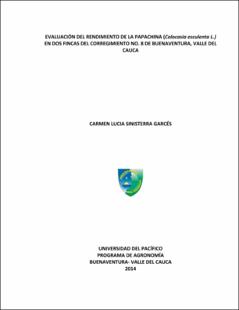Mostrar el registro sencillo del ítem
Evaluación del rendimiento de la papachina (colocasia esculenta l.) en dos fincas del corregimiento n°. 8 de Buenaventura Valle del Cauca
| dc.contributor.advisor | Ararat Orozco, Milton Cesar | spa |
| dc.contributor.author | Sinisterra Garcés, Carmen Lucia | spa |
| dc.date.accessioned | 2021-06-10T21:15:45Z | |
| dc.date.available | 2021-06-10T21:15:45Z | |
| dc.date.issued | 2014 | spa |
| dc.identifier.uri | https://repositorio.unipacifico.edu.co/handle/unipacifico/206 | |
| dc.description | Disponible en formato físico T ATH 09 2014 | spa |
| dc.description.abstract | Se evaluó el rendimiento de la Papachina, en dos fincas del corregimiento n°8 de Buenaventura. Los componentes fisiológicos, área foliar, número de brotes, número de hojas, número de pseudotallos y variables de rendimiento diámetro (tamaño) del centro y longitud del tubérculo g/planta, volumen del tubérculo, peso fresco del tubérculo g/planta, materia seca se evaluaron al momento de la cosecha. | spa |
| dc.description.tableofcontents | 1. PLANTEAMIENTO DEL PROBLEMA 2. JUSTIFICACIÓN 3. INTRODUCCIÓN 4. OBJETIVOS 4.1. OBJETIVO GENERAL 4.2. OBJETIVO ESPECÍFICOS 5. REVISIÓN DE LITERATURA 5.1 ORIGEN DE LA PAPACHINA 5.2 CLASIFICACIÓN BOTÁNICA 5.2.1 IMPORTANCIA 5.2.2 VALOR NUTRITIVO 5.2.3. USO DE PAPA CHINA 5.3. DESCRIPCIÓN BOTÁNICA 5.3.1. CICLO DE CRECIMIENTO 5.3.2. REQUERIMIENTOS EDÁFICOS Y CLIMÁTICOS 5.4. AGRONOMÍA DEL CULTIVO DE PAPA CHINA 5.4.1. MÉTODO DE PROPAGACIÓN 5.4.2. PREPARACIÓN DEL SUELO 5.4.3. DENSIDAD DE PLANTACIÓN 5.4.4. PLANTACIÓN 5.4.5. ÉPOCA DE SIEMBRA 5.5.6. SISTEMA DE SIEMBRA 5.5.7. MANEJO DEL AGUA 5.4.8. CONTROL DE ARVENSES 5.5. PLAGAS Y SU CONTROL 5.6. ENFERMEDADES Y CONTROL 5.7. COSECHA Y RENDIMIENTO 5.8. MANEJO DE COSECHA 5.8.1. CURACIÓN 5.8.3. ALMACENAMIENTO 6. MATERIALES Y MÉTODOS 6.1 UBICACIÓN GEOGRÁFICA 6.1.1 CARACTERÍSTICAS DEL SITIO DE ESTUDIO 6.1.2 MATERIALES PARA EL MUESTREO Y PROCESAMIENTO 6.2. METODOLOGÍA 6.2.1 INFORMACIÓN DEL RECONOCIMIENTO DEL TERRENO 6.2.2 VARIABLES DE RESPUESTAS FISIOLÓGICAS 6.2.3 VARIABLES DE RENDIMIENTO 6.4 MANEJO DEL EXPERIMENTO 6.3.1 ENCUESTAS DE LA ZONA 6.3.2 RECORRIDO EN CAMPO PARA LA IDENTIFICACIÓN DE LAS FINCAS A EVALUAR 6.3.3 ÁREA CULTIVADA DE PAPACHINA 6.3.4 COSECHA 6.4 MUESTREO DEL EXPERIMENTO 6.5 MANEJO DE LA INFORMACIÓN 6.6 ANÁLISIS ESTADÍSTICO 7. RESULTADOS Y DISCUSIÓN 7.1. RECONOCIMIENTO DEL TERRENO 7.1.1. VARIABLES FISIOLÓGICAS 7.1.2. ÁREA FOLIAR 7.1.3. NÚMERO DE BROTES O HIJUELOS/PLANTA 7.1.4. NÚMERO DE HOJAS/PLANTA 7.1.5. NÚMERO DE PSEUDOTALLOS 5.8. MANEJO DE COSECHA 5.8.1. CURACIÓN 5.8.3. ALMACENAMIENTO 6. MATERIALES Y MÉTODOS 6.1 UBICACIÓN GEOGRÁFICA 6.1.1 CARACTERÍSTICAS DEL SITIO DE ESTUDIO 6.1.2 MATERIALES PARA EL MUESTREO Y PROCESAMIENTO 6.2. METODOLOGÍA 6.2.1 INFORMACIÓN DEL RECONOCIMIENTO DEL TERRENO 6.2.2 VARIABLES DE RESPUESTAS FISIOLÓGICAS 6.2.3 VARIABLES DE RENDIMIENTO 6.4 MANEJO DEL EXPERIMENTO 6.3.1 ENCUESTAS DE LA ZONA 6.3.2 RECORRIDO EN CAMPO PARA LA IDENTIFICACIÓN DE LAS FINCAS A EVALUAR 6.3.3 ÁREA CULTIVADA DE PAPACHINA 6.3.4 COSECHA 6.4 MUESTREO DEL EXPERIMENTO 6.5 MANEJO DE LA INFORMACIÓN 6.6 ANÁLISIS ESTADÍSTICO 7. RESULTADOS Y DISCUSIÓN 7.1. RECONOCIMIENTO DEL TERRENO 7.1.1. VARIABLES FISIOLÓGICAS 7.1.2. ÁREA FOLIAR 7.1.3. NÚMERO DE BROTES O HIJUELOS/PLANTA 7.1.4. NÚMERO DE HOJAS/PLANTA 7.1.5. NÚMERO DE PSEUDOTALLOS 7.2.2. VARIABLES DE RENDIMIENTO 7.2.2.1. DIÁMETRO (TAMAÑO) DEL CENTRO Y LONGITUD DEL TUBÉRCULO(VOLUMEN) 7.2.2.2. PESO FRESCO DEL TUBÉRCULO (PESO CON CASCARA) 7.2.2.3. PESO SIN CASCARA DEL TUBÉRCULO 7.2.2.4. PESO DE CASCARA DEL TUBÉRCULO 7.2.3. MATERIA SECA CONCLUSIONES RECOMENDACIONES REFERENCIAS BIBLIOGRÁFICAS ANEXOS | spa |
| dc.publisher | Universidad del Pacífico | spa |
| dc.rights | Derechos Reservados - Universidad del Pacifico | spa |
| dc.rights.uri | https://creativecommons.org/licenses/by-nc/4.0/ | spa |
| dc.title | Evaluación del rendimiento de la papachina (colocasia esculenta l.) en dos fincas del corregimiento n°. 8 de Buenaventura Valle del Cauca | spa |
| dc.type | Trabajo de grado - Pregrado | spa |
| dcterms.references | ANGULO, CASTILLO, Karol. Evaluación de la deficiencia de nitrógeno, fósforo y potasio en Papachina (Colocasia esculenta) cultivada bajo condiciones hidropónicas en el municipio de Buenaventura, 2009.trabajo de investigación Universidad del Pacifico. Programa de Agronomía. Valle del Cauca. | spa |
| dcterms.references | BRADBURY, D.; HOLLOWAY, W.1988. Chemistry of tropical root crops.ACIAAR, Canberra. | spa |
| dcterms.references | BOOTE, K., M. KROPFF and P. BINDRABAN. 2001. Physiology and modeling of traits in crop plants: Implications for genetic improvement. Agric. Syst. 70:395-42 | spa |
| dcterms.references | CLAVIJO, J. 1989. Análisis del crecimiento en malezas. En: Revista Comalfi 26, 12-16 | spa |
| dcterms.references | CHING, K. 1970. Developent of starch, protein, leaf and corm in Colocasia esculenta, Proc. 2ind int. Symp.Trop.Root.TuberCrops.pp: 143-146. | spa |
| dcterms.references | COURSEY, D. 1968.The edible aroids. World Crops.pp: 25-30. | spa |
| dcterms.references | ENRÍQUEZ, Danelia Yudith y Mairena, Erick Noel. efecto de dos condiciones de humedad del suelo y tiempo de cosecha sobre el rendimiento de malanga (Colocasia esculenta L. schott) para exportación, Bocao- Nicaragua 2011.Trabajo de grado. Managua.: Universidad Nacional agraria. Facultad de agronomía. 2011. | spa |
| dcterms.references | Eslava R., Jesús A. Climatología del Pacifico Colombiano. Academia Colombiana de ciencias Geográficas. Bogotá.1994; 77p. | spa |
| dcterms.references | ESTRADA, E.; GALVIS, F.1978. Enfermedades de la papachina o taro, Colocasia esculenta (L) Schott, en la costa Pacífica del Valle del Cauca. S/Ed. Universidad Nacional de Colombia. Palmira - Colombia. Pp: 121. | spa |
| dcterms.references | EZUMAH, H.; PLUCKNETT, D. 1973, Response of taro, colocasia esculenta (L.) Schott, to wáter management, plot preparation and population.3rd Int. Symp. Trop. Roop Crops Ibadan – Nigeria. | spa |
| dcterms.references | EZUMAH, H.1973.Thegrowthanddevelopment of papachina Colocasia esculenta (L.) Schott, in relation to select cultural management practice. Diss Abstract International. pp: 24. | spa |
| dcterms.references | FAO, 2010. Taro cultivation in Asia and the Pacific. Consultado el 17 de junio de 2014. | spa |
| dcterms.references | FREIRE B, (2012). Entrevista al Ingeniero Bolívar Freire, en CODEAMA. Puyo-Pastaza | spa |
| dcterms.references | GRIFFIN, G. Y WANG, J. 1983. Industrial Uses of Taro: a Review of Colocasia esculenta and its potentials. University of Hawaii Press. Honolulu, p 301-312. | spa |
| dcterms.references | KAY, D. 1987. Crop and product digest No. 2 Root crops. 2nd Edition. London: tropical Development and research Institute.pp: 380. | spa |
| dcterms.references | LÓPEZ ZADA, M.; E. VÁZQUEZ Y R. LÓPEZ, FLEITES. 1995. Raíces y tubérculos, Ciudad de La Habana. Editorial Pueblo y Educación. 2. Malanga, pág. 98-162.Cuba. —312p. | spa |
| dcterms.references | MAPES, M.1973. Mericloning of taro varieties, Colocasia esculenta (L) Schott. 3rd Int. Symp.Trop.Root Crops Ibandan- Nigeria. | spa |
| dcterms.references | MATSUMOTO, B.; NISHDA, T.1966.Predator-prey investigations on the taro leaftpper and its egg predator. Technical Bulletin 64.agricultural Experiment Station. Honolulu – Hawai.pp:32 | spa |
| dcterms.references | MCEWAN, R. 2008. Colocasia esculenta. PhD Thesis. University of Zululand, p 28-35. | spa |
| dcterms.references | MILLER, C.; ROSS, W.: LOUIS, L. 1947 Hawaiian-grow vegetables. AgriculturalExperimentStation. Editorial Blume.Mexico D.F.- Mexico. pp: 348-356. | spa |
| dcterms.references | MONTALDO, A. y Pinedo, M.1975.Tipos de Cultivos – Hortalizas Amazónicas – Name 1991.Ecuatorial páginas. Apoyo Agro Tecnología innovación. Agrícola Cultivos.Pp.131- 162. | spa |
| dcterms.references | MONTALDO, A. 1991. Cultivos de Raices y Tubérculos Tropicales. Editorial IICA. Costa Rica pp: 13-67. | spa |
| dcterms.references | MOSQUERA, E y Cárdenas, D. 2008. Sectores de mayor producción de papa china de las provincias amazónicas. Gobierno provincia de Pastaza. | spa |
| dcterms.references | ONWUEME, I. 1978. Tropical Tuber Crops. John Wiley and Sons. New York EE.UU. pp: 199– 225. | spa |
| dcterms.references | OPARA Linus. Edible aroids: Post - Harvest Operation. | spa |
| dcterms.references | OYENUGA, v. 1968. Nigeria, s foods and feeding stuffs. University of Ibadan press. Ibadan – Nigeria. pp. 99. | spa |
| dcterms.references | PAC, Asociación pueblos en acción comunitaria. (2009).malanga coco. Consultado en línea) 30 de enero 2015, en http://cenida.una.edu.ni/Tesis/tnp33e59.pdf | spa |
| dcterms.references | PEÑA, R. de la 1970. The edible aroids in the Asia – Pacific area. In 2nd International Symposium on Tropical Root Crops. University of Hawaii, College of Tropical Agriculture. Honolulu – Hawái, Proceeding v. 1: 136 – 140. | spa |
| dcterms.references | PEÑAFIEL VILLACRÉS, MÓNICA.; 2009. efecto de la aplicación edáfica del silicio en diferentes dosis, en el cultivo de la papa china (Colocasia esculenta) en combinación con dos niveles de abono orgánicos”. | spa |
| dcterms.references | PLUCKNETT, D. 1979. Small-scale Processing and Storage of Tropical Root Crops, (Ed.D.L.Plucknett).WestviesTrop.Agr. Series, no.1. Boulder, Colorado: West view Press.pp.275-299. | spa |
| dcterms.references | PUREWAL, S.; DARGAN, K.1957. Effects of spacing on development and yield of arum (Colocasia esculenta).Indian Journaly agricultural Science, 27 pp: 151-162. | spa |
| dcterms.references | QUIÑONEZ, CANDELO, Elizabeth. Caracterización agromorfológica de tres variedades de Papachina (Colocasia esculenta (L) Schott), en Zacarías zona rural de Buenaventura, 2010, Trabajo de investigación. Universidad del Pacifico. Programa de Agronomía. | spa |
| dcterms.references | SEGURA, A, SABORÍO, D y V, Sáenz, Marco. 2003. Algunas normas de calidad en raíces y tubérculos tropicales de exportación de costa rica | spa |
| dcterms.references | SEWELL, L.; HEALEY, P.1979. Distribution of calcium oxalate crystal idioblastincormsof taro (Colocasia esculenta). American Journal of Botany 66.pp: 1029-1032. | spa |
| dcterms.references | SINGH, S. 1991. Bean genetics. In: A van Schoonhoven and O Voysest (eds.) Common beans: Research for crop improvement. CAB International/CIAT, Wallingford. UK. 199-249. | spa |
| dcterms.references | SILVA, J. da; COUTO, F.; TIGCHELAAR, E. 1971. Effects of spacing, fertilizer application and size of setts on the yield of cocoyam, Colocasia esculenta Schott. Experiential.pp: 135 - 154. | spa |
| dcterms.references | SINVAN, P.1973. Effects of spacing in taro (Colocasia esculenta).3rd Internacional Symposium on tropical Root Crops. Ibadan – Nigeria. | spa |
| dcterms.references | SMITH, O.D. 1976. Potatoes production storage and processing. De AVI Publishing Company. Inc. U.S.A. pp. 199-206. | spa |
| dcterms.references | STANDAL, B. 1970 the nature of poi carbohidrates.In 2ndinternacional Symposium on Tropical Root Crops. University of Hawai, College of Tropical agriculture. Hono lulu – Hawai. Proceeding v 1: 146 -148. | spa |
| dcterms.references | RODRIGUEZ, G., D.AREVALO, S., I.1.986."análisis de crecimiento y producción de materia seca en avena forrajera (avena sativaL.) bajo tres distancias y tres densidades de siembra" | spa |
| dcterms.references | WARID, W.1970.Trends in the production of taro in Egypt. In 2nd Internacional Symsposium on Tropical Root Crops. University of Hawaii, College of tropical Agriculture. Honolulu – Hawai.Proceedings v. 1: 141 - 142. | spa |
| dcterms.references | WHITE, J. 1985. Conceptos básicos de fisiología vegetal del frijol (Phaseolus vulgaris L). In: M. López, F. Fernández y A. van Schoonhoven, (eds.) Frijol: Investigación y Producción. CIAT. Cali, Colombia. 43-57. | spa |
| dc.description.notes | Trabajo de grado (Agronomía) Universidad del Pacífico, 2014 | spa |
| dc.description.degreelevel | Pregrado | spa |
| dc.description.degreename | Agrónomo(a) | spa |
| dc.publisher.place | Colombia | spa |
| dc.publisher.program | Agronomía | spa |
| dc.rights.accessrights | info:eu-repo/semantics/openAccess | spa |
| dc.rights.creativecommons | Atribución-NoComercial 4.0 Internacional (CC BY-NC 4.0) | spa |
| dc.subject.proposal | Cultivo de papachina | spa |
| dc.subject.proposal | Valor nutritivo | spa |
| dc.subject.proposal | Papachina | spa |
| dc.type.coar | http://purl.org/coar/resource_type/c_7a1f | spa |
| dc.type.coarversion | http://purl.org/coar/version/c_970fb48d4fbd8a85 | spa |
| dc.type.content | Text | spa |
| dc.type.driver | info:eu-repo/semantics/bachelorThesis | spa |
| dc.type.redcol | http://purl.org/redcol/resource_type/TP | spa |
| dc.identifier.local | 12631 | spa |
| dc.type.version | info:eu-repo/semantics/publishedVersion | spa |
| dc.identifier.signature | T ATH 09 2014 | spa |
| dc.rights.coar | http://purl.org/coar/access_right/c_abf2 | spa |
Ficheros en el ítem
Este ítem aparece en la(s) siguiente(s) colección(ones)
-
AB. Agronomía [107]










